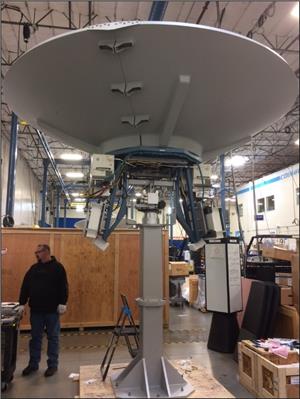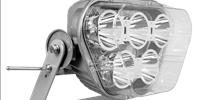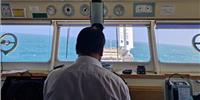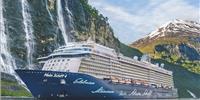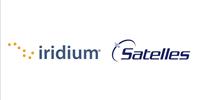Cobham has introduced a new technology platform for its expanded line of Sea Tel land-based tracking antennas. Designed as an enabler for the new breed of emerging high throughput LEO/MEO constellations that leverage CubeSat and SmallSat spacecraft, Cobham’s new tracking antennas lower the total cost of ownership by reducing power consumption, in addition to delivering tangible savings on deployment and maintenance.
Cobham’s next generation solution is delivered as a complete, integrated system including radome, antenna controller, feeds and customer specific RF (BUC and LNB) in addition to a built-in auto-tracking feature, improving link performance and contributing to higher throughput and availability of service for the end-user.
Cobham’s new Tracker range is currently available for L, S, C, X, Ku, Ka and E-band with antenna reflector sizes between 60 cm to 6 m. Developed from the bottom up to merge over 20 years of Sea Tel land tracking antenna experience with Cobham’s maritime antenna stabilization technology, the life-time cost savings facilitated by the new Tracker series supports established network operators and venture-funded start-ups to deliver even more competitive high-throughput satcom services for diverse users. Cobham has also addressed the traditional long lead time to delivery in the land-based tracking antenna segment, committing significant capacity to supporting mobility and growth in the LEO/MEO markets.
Headlining the unique new Sea Tel Tracker product line feature-set is Cobham’s new 3-Axis Zero Gravity technology for land antennas, which balances the entire system to deliver a step-change in power consumption for Cobham customers. The solution co-locates the antenna’s centre of gravity with its centre of rotation, resulting in an effortless track that requires almost no power. Regardless of size, all new Sea Tel Tracker antennas consume just 200 Watts, with further saving possible through the use of a 500-Watt back-up generator, compared to the >5KW back-up generator needed for competing antennas. A 90 percent reduction in capital outlay to provide power infrastructure can be achieved, while an 87 percent power consumption saving is typical, according to the manufacturer.
Cobham said its development team has considered all aspects of the total cost of ownership for the new Sea Tel Tracker range resulting in even more savings, including on the cost of site preparation and antenna deployment. Traditional land tracking antennas of over five meters in size require substantial foundations (up to 15ft) in order to ensure the antenna can operate and survive in high winds as well as negate shift in the base over time as the foundation settles. Due to the system’s balance, Cobham’s new tracking antennas can operate in winds up to 155 mph, installed on just a 12 inch thick concrete grade pad with minimal rebar. They can even be installed temporarily on a bed of gravel while still maintaining a strong link to the network. This is achieved by automatic calibration routines which compensate for the movement of the base over time.
“The significant time and personnel commitment required to assemble antenna systems greatly contributes to the cost of system installation,” said Kirby Nell, Business Manager Large VSAT, Cobham SATCOM. “Traditional land tracking systems can take several months to build the foundation, pull power cables, install automatic power supplies and finally install the precision aligned and levelled antennas. It’s a complex, costly task, but Cobham has developed a better and simpler approach. Sea Tel Tracker antennas can be built by two skilled technicians in a matter of days. We have a heritage of being able to assemble systems quickly and easily for the maritime market, which informs our approach to deployment of the Tracker range.”
Further life-time cost savings for LEO/MEO network operators have been achieved by simplifying and reducing the requirements for on-site maintenance. Uniquely designed as a single unit, housing all components in the radome itself, the Sea Tel Tracker product line provides industry-leading Mean Time Between Failures (MTBF), so fewer engineer visits are required during the antenna’s lifecycle. Cobham’s sophisticated system design and intelligent component selection has simplified the overall system architecture, so many standard maintenance tasks take less than an hour, while many service issues can be handled remotely.
“By renewing our land tracking antenna technology platform, we can provide satellite network operators the ability to achieve a massive reduction in their operational overheads,” adds Pete Blaney, Chief Engineer, Cobham SATCOM. “Lowering the total cost of ownership across the network development and operational stages to such a level, our new Sea Tel Tracker range is set to become a catalyst for the industry to develop and implement more disruptive services that are not only possible at a new price-point for the network owner but will also help to bring costs down for end-users, while increasing performance and availability of service.”
